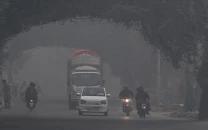Villages on riverbanks brace for flooding
Heavy monsoon, glacier melt trigger warnings

A fresh forecast has been issued for flooding in major rivers as water inflows increase due to continued monsoon rains and accelerated glacier melt in the northern regions.
According to the latest advisory issued by the National Disaster Management Authority (NDMA), moderate flooding is currently being observed in the Indus River at Chashma and Taunsa barrages, while low-level flooding persists at Tarbela, Kalabagh and Sukkur barrages.
However, the flow in the River Kabul around Nowshera and its adjoining tributaries remains normal.
The release of additional water from India into the Sutlej River has exacerbated flood conditions in southern Punjab, raising water levels at Head Sulemanki and Head Islam.
The Sutlej is experiencing low flood at Ganda Singh Wala and Head Suleimanki, while the Jhelum and its tributaries continue to flow at routine levels.
Similarly, the Chenab is flowing normally at key points, although its nullahs Aik and Palkhu are registering low floods.
Flow in the Ravi remains stable at major sites. However, low-level flooding is underway in the Basantar Nullah. Water levels in hill torrents across the Dera Ghazi Khan Division remain negligible.
Meanwhile, reservoir levels have shown a marked increase, with Tarbela Dam currently 99% full and Mangla Dam at 74% of its capacity.
In Bahawalpur, the Zamindara Bund near Dera Bikha broke, submerging thousands of acres of crops, and Empress Bridge experienced rising water pressures. In Kasur, villages near Ganda Singh Wala reported severe crop damage, while precautionary measures have been implemented in Pakpattan and Arif Wala.
In Sindh, high flood levels at the River Indus near Tunsa have submerged over 60 settlements, affecting low-lying areas including Tunsa, Drahma, and Ghazi Ghat. Authorities have instructed residents to evacuate for safety.
The ongoing floods highlight the urgent need for disaster preparedness and relief operations across Pakistan as monsoon rains continue.
The country has witnessed severe losses due to heavy rainfall and floods, with the National Disaster Management Authority (NDMA) reporting 41 fatalities and 11 injuries in the past 24 hours alone. Among the deceased were 29 men, 9 women, and 3 children.
Provincial breakdown of recent casualties includes 19 deaths and one injury in Khyber Pakhtunkhwa (KP), 11 deaths and 5 injuries in each Gilgit-Baltistan, and Sindh.
Since the onset of the monsoon, nationwide figures have risen sharply. A total of 748 people have lost their lives and 978 have been injured. Fatalities include 459 men, 111 women, and 178 children, while injuries encompass 475 men, 243 women, and 260 children.
NDMA's data also reveals regional impacts: 165 deaths in Punjab, 446 in KP, 40 in Sindh, 45 in Gilgit-Baltistan, 22 in Azad Kashmir, and 8 in Islamabad. The floods and rains have destroyed 990 homes and killed 3,898 livestock.




















COMMENTS
Comments are moderated and generally will be posted if they are on-topic and not abusive.
For more information, please see our Comments FAQ